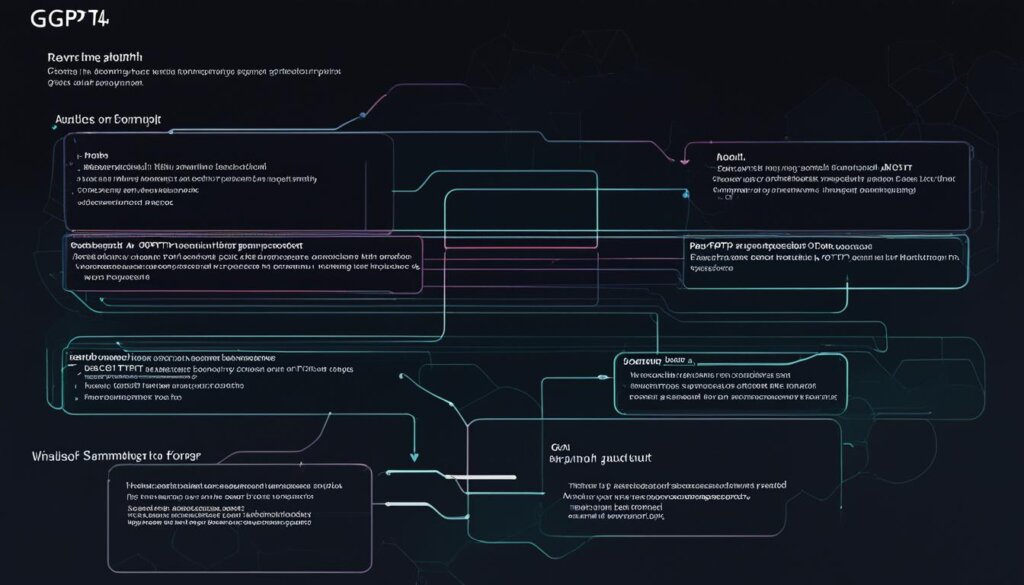Table of Contents
GPT-4 marks a significant milestone in AI, particularly in natural language processing. It is the latest iteration of the Generative Pre-trained Transformers (GPT) model. GPT-4 has advanced capabilities that are changing the digital landscape with unparalleled insights.
What are Generative Pre-trained Transformers?
Generative Pre-trained Transformers (GPT) are deep learning models used to generate human-like text. These models, powered by state-of-the-art natural language processing techniques, have revolutionized various applications such as text generation, language translation, answer generation, and content creation.
Using advanced deep learning algorithms, GPT models employ large-scale training on diverse datasets to learn the patterns and structure of language. This enables them to generate highly coherent and contextually relevant text, mimicking human-like language generation.
GPT models have found extensive applications across industries and disciplines. Here are some key areas where GPT models excel:
- Question Answering: GPT models can generate accurate and informative answers to a wide range of questions, making them valuable tools in information retrieval and knowledge dissemination.
- Summarization: These models can effectively summarize long pieces of text, extracting important information and condensing it into concise summaries. This aids in quick information extraction and saves time for users.
- Translation: With their ability to understand and generate text in multiple languages, GPT models are instrumental in language translation tasks, facilitating effective cross-lingual communication.
- Code Generation: GPT models can generate code snippets based on given prompts or specifications, assisting developers in automating routine coding tasks and speeding up software development processes.
- Content Creation: These models can generate engaging and coherent content, making them valuable tools for content creators in fields such as blog writing, storytelling, and creative writing.
One of the significant advantages of GPT models is their ability to be fine-tuned on specific datasets, allowing them to better adapt to specific domains or tasks. By fine-tuning the models, their performance can be improved in specific applications, resulting in more accurate and contextually appropriate text generation.
Moreover, GPT models save computing time and resources compared to other traditional models. Their efficient training and inference process make them suitable for deployment in resource-constrained environments, opening up opportunities for wider adoption in various industries.
With the continuous advancements in natural language processing and deep learning, we can expect the development of more sophisticated and capable GPT models in the future. These models hold immense potential in revolutionizing communication, content creation, and human-computer interaction.
Evolution of GPT Models: From BERT to GPT-3
The development of Generative Pre-trained Transformers (GPT) models has been a remarkable journey, starting with the advent of transformer models and culminating in the release of GPT-3. Let’s delve into the evolution of these groundbreaking models and their significance in language understanding.
Prior to transformer models, the field of text generation relied on recurrent neural networks (RNNs) and long short-term memory (LSTM) models. However, a significant breakthrough came in 2017 with the introduction of Google’s BERT, which revolutionized natural language processing by leveraging self-attention mechanisms.
| GPT Model | Release Year | Key Features |
|---|---|---|
| GPT-1 | 2018 | Proof-of-concept model |
| GPT-2 | 2019 | Impressive state-of-the-art performance |
| GPT-3 | 2020 | Unprecedented scale with 100 times more parameters than GPT-2 |
GPT-1 was a proof-of-concept model that laid the foundation for subsequent advancements. It showcased the potential of transformers in language generation tasks. Building upon GPT-1’s success, OpenAI unveiled GPT-2 in 2019, which set a new benchmark for performance in text generation. Its remarkable ability to generate human-like text captivated the AI community and sparked significant interest.
However, it was GPT-3, released in 2020, that truly pushed the boundaries of what was thought possible. With a staggering 175 billion parameters, GPT-3 boasted unparalleled capabilities in generating vast amounts of contextually coherent text. This breakthrough model demonstrated remarkable language understanding, making it a powerful tool for numerous applications.
The evolution of GPT models has paved the way for advancements in natural language processing and opened up possibilities for diverse domains such as chatbots, content creation, and language translation.
Next, we delve into the advancements introduced by GPT-4 and the exciting new possibilities it brings.
Introducing GPT-4: Advancements and Performance Improvements
GPT-4 represents a significant leap forward in AI technology, with notable advancements and performance improvements. This latest iteration of the Generative Pre-trained Transformers (GPT) model introduces key features that enhance its capabilities and make it a powerful tool across various domains.
Model Alignment and Factual Correctness
One of the major advancements in GPT-4 is improved model alignment, which contributes to greater factual correctness in its outputs. This means that GPT-4 is more adept at generating truthful information and less likely to produce misleading or inaccurate content. As a result, users can rely on GPT-4 to provide reliable and fact-checked information, making it a valuable resource for research, content creation, and decision-making processes.
Steerability and Versatility
GPT-4 introduces enhanced steerability, allowing users to command the model to write in different styles or tones. This newfound versatility enables content creators to tailor the output to specific requirements, be it a formal academic tone, engaging storytelling, or persuasive marketing content. By giving users more control over the generated text, GPT-4 becomes a versatile tool compatible with a wide range of applications.
Integration of Visual Inputs
Perhaps one of the most exciting improvements in GPT-4 is its ability to accept visual inputs. This means that users can provide complex visual imagery to GPT-4, which the model can interpret and generate text based on. This integration of visual inputs opens up a whole new dimension of creative possibilities, enabling GPT-4 to describe images in detail, generate captions, or even aid in visual storytelling.
With this breakthrough, GPT-4 demonstrates its adaptability and versatility across various domains, including content creation, image analysis, and creative writing.
Performance Benchmarks
GPT-4 sets new benchmarks in performance by achieving human-level proficiency on professional and academic tasks. It outperforms previous versions like GPT-3.5, demonstrating superior factual correctness, improved model alignment, and enhanced steerability. These advancements make GPT-4 the go-to choice for individuals and organizations seeking advanced AI capabilities that align with their specific needs and requirements.
To illustrate the performance of GPT-4, consider the following table showcasing a comparison of key metrics:
| Model | Model Alignment | Factual Correctness | Steerability | Visual Inputs |
|---|---|---|---|---|
| GPT-3.5 | Good | High | Limited | No |
| GPT-4 | Excellent | Exceptional | Advanced | Yes |
This table clearly demonstrates how GPT-4 surpasses GPT-3.5 in various aspects, offering improved model alignment, factual correctness, steerability, and the ability to process visual inputs. These advancements signify a quantum leap in AI technology and pave the way for transformative applications across multiple industries.
Accessing GPT-4: Availability and OpenAI Evals
GPT-4, the next generation AI model, offers advanced capabilities that are revolutionizing natural language processing. While GPT-4 is an impressive innovation, accessing its features requires understanding the available options and evaluation methods.
GPT-4 Access for ChatGPT Plus Users
If you’re a ChatGPT Plus user, you already have access to GPT-4’s remarkable text input capability. This means you can experience the power of GPT-4 in generating human-like text, answering questions, creating content, and much more. ChatGPT Plus subscribers enjoy enhanced access to the latest AI technology.
GPT-4 API Waitlist
For developers and businesses looking to integrate GPT-4 into their applications and products, OpenAI offers access to GPT-4 through the GPT-4 API. However, as of now, the GPT-4 API is available via a waitlist. This allows OpenAI to carefully control the rollout and ensure a high-quality user experience.
Enhanced Capabilities: Image Input
One of the key advancements in GPT-4 is its image input capability. While this feature has not been publicly announced, it has the potential to revolutionize AI capabilities. GPT-4’s ability to interpret complex imagery and generate text based on visual inputs opens up new possibilities in fields such as image description, content generation, and more. Stay tuned for future announcements regarding the availability of GPT-4’s image input capability.
OpenAI Evals: Contributing to Improvements
OpenAI believes in a collaborative approach to AI development. They have released OpenAI Evals, which allows users to evaluate AI models and report shortcomings. By providing valuable feedback and contributing to the evaluation process, users can actively participate in refining AI models like GPT-4. OpenAI Evals empowers the community to shape the future of AI and contribute to ongoing improvements in AI technology.

Applications and Potential of GPT-4
GPT-4, the next generation AI model, is set to revolutionize education, productivity, and various other fields with its advanced capabilities. Let’s explore the diverse applications and potential of GPT-4 and how it can positively impact our lives.
1. Education
GPT-4 has the potential to reshape education by acting as a personalized AI tutor. With its natural language processing capabilities, GPT-4 can provide tailored and interactive learning experiences on a wide range of subjects. Students can receive instant feedback, explanations, and guidance, enhancing their understanding and knowledge retention.
2. Productivity
Whether you’re a professional or a student, GPT-4 can significantly boost productivity. It can assist in programming and debugging, offering suggestions, code generation, and problem-solving. With GPT-4’s ability to generate human-like text, it can also streamline content creation, enabling writers, marketers, and content creators to produce high-quality material more efficiently.
3. AI Tutoring in Diverse Fields
GPT-4’s AI tutoring capabilities extend beyond the traditional subjects. It can provide guidance and insights in various fields, such as language learning, mathematics, science, history, and more. Its adaptability and vast knowledge base make it an invaluable resource for learners of all ages and disciplines.
| Applications | Description |
|---|---|
| Personalized AI Tutoring | GPT-4 can offer tailored lessons, explanations, and feedback in multiple subjects, revolutionizing the learning experience. |
| Enhanced Productivity | GPT-4 can assist in programming, debugging, content creation, and other tasks, increasing efficiency and output. |
| Multi-Disciplinary Guidance | With its vast knowledge base, GPT-4 can support learners in diverse fields, providing valuable insights and assistance. |
4. Image Description and Analysis
Incorporating image analysis capabilities, GPT-4 can describe images in detail, making it a powerful tool for visually impaired individuals and enriching the understanding of visual content. It can also analyze complex imagery, enabling it to generate text-based descriptions or explanations based on visual inputs.
5. Complex Language Tasks
GPT-4’s advanced language processing abilities make it capable of handling complex language tasks such as legal document analysis, nuanced writing, and translation. Its proficiency in understanding language intricacies makes it a valuable asset in various professional and academic contexts.
“GPT-4’s potential in education, productivity, and diverse fields is immense. Its AI tutoring capabilities can revolutionize learning, while its productivity enhancements and language processing skills make it a powerful tool for various industries.”
GPT-4 is poised to enhance daily life by improving learning outcomes, organization, skill development, and overall efficiency. The applications and potential of GPT-4 extend to numerous domains, offering transformative possibilities for individuals and industries alike.
GPT-4 and the Future of AI
The partnership between OpenAI and Microsoft signifies a landmark collaboration in making AI technology accessible and beneficial for everyone. GPT-4, the latest AI marvel resulting from various technological advancements, shows incredible potential in shaping the future of artificial intelligence. As the horizon expands to allow wider access to GPT-4 and similar AI models, responsible usage becomes paramount in harnessing this revolutionary technology effectively.
The future of AI lies in continuous learning, improvement, and transparency. OpenAI and Microsoft’s combined efforts strive towards this vision, ensuring that GPT-4 evolves in a responsible manner. With increased transparency, users can better understand and navigate the capabilities and limitations of AI systems, establishing trust and confidence in their deployment.
Anticipating a future with GPT-4 at the forefront, it is crucial for individuals, organizations, and society as a whole to embrace responsible usage. This entails considering ethical implications, addressing biases, and using AI technology for the betterment of humankind. The collaboration between OpenAI and Microsoft exemplifies a commitment to advancing AI technology responsibly while fostering innovation and inclusive access.
As we look ahead, GPT-4 and similar advancements in AI technology hold great promise in revolutionizing industries and transforming the way we live and work. With collaborative efforts and a conscientious approach to deploying AI, we can unlock the full potential of GPT-4 and shape a future enriched by the unprecedented capabilities of artificial intelligence.
FAQ
What is GPT-4?
GPT-4 is the latest iteration of the Generative Pre-trained Transformers (GPT) model and represents a significant milestone in AI, particularly in natural language processing.
What are Generative Pre-trained Transformers?
Generative Pre-trained Transformers (GPT) are deep learning models used to generate human-like text. They have various applications such as answering questions, summarizing text, translating languages, generating code, and creating content like blog posts and stories.
How did GPT models evolve?
GPT models evolved from the invention of transformer models, starting with Google’s BERT in 2017. Before transformers, text generation relied on deep learning models like RNNs and LSTMs. GPT-1 was a proof-of-concept model, while GPT-2 achieved state-of-the-art performance. GPT-3, released in 2020, had 100 times more parameters than GPT-2 and showed tremendous capabilities in generating human-like text.
What advancements does GPT-4 bring?
GPT-4 improves model alignment, making it more truthful and less likely to generate offensive or dangerous output. It outperforms GPT-3.5 in factual performance and demonstrates improved steerability, allowing users to command it to write in different styles or tones. GPT-4 can also use image inputs, interpreting complex imagery and generating text based on it. Performance benchmarks show that GPT-4 achieves human-level performance on professional and academic tasks, surpassing existing models.
How can I access GPT-4?
GPT-4’s text input capability is currently available to ChatGPT Plus users, while the image input capability has not yet been announced for public availability. Access to GPT-4 through the API is available via a waitlist. OpenAI has also released OpenAI Evals, a framework for evaluating AI models, allowing users to report shortcomings and contribute to further improvements.
What are the applications of GPT-4?
GPT-4 has immense potential in revolutionizing education by providing personalized AI tutoring on various subjects. It can also boost productivity, assist in programming and debugging, describe images in detail, and handle complex language tasks like legal document analysis. GPT-4 can enhance daily life in numerous ways, improving learning, organization, and skill development.
What does the future hold for GPT-4 and AI?
The partnership between OpenAI and Microsoft aims to make AI technology accessible and useful to everyone. GPT-4, born from various technological advancements, holds incredible promise for shaping the future. As we anticipate wider access to GPT-4 and similar AI, it is crucial to approach this revolutionary technology with understanding and responsible usage. The future of AI lies in continuous learning, improvement, and transparency to fully harness its benefits.







